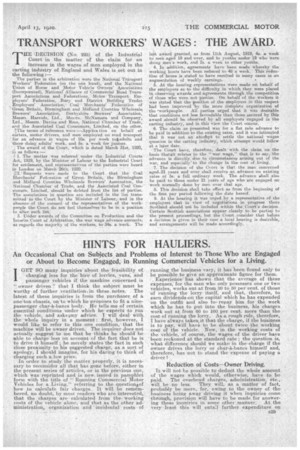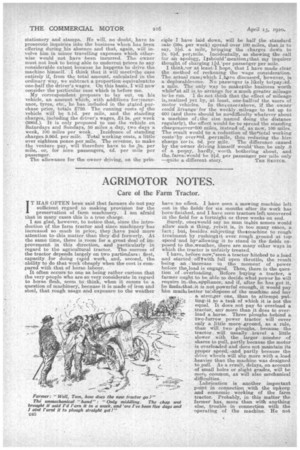HINTS FOR HAULIERS.
Page 21

Page 22

If you've noticed an error in this article please click here to report it so we can fix it.
An Occasional Chat on Subjects and Problems of Interest to Those Who are Engaged or About to Become Engaged in Running Commercial Vehicles for., a Living.
IGET SO many inquiries about the feasibility of charging less for the hire of lorries, :ya,i* and passenger vehicles if the machine concerned is _ "ownerdriven " that I think the subject must be worthy of further ventilation. in these. notes. The latest of these inquiries is from the purchaser of a one-ton chassis, on to which he proposes to fit a ninepassenger char-a-banc6 body. He tells me of certain visential conditions Tinder which he expects to run the vehicle, and asks ply advice. I will deal With. the whole inquiry in a moment : first, however, I would like -t,o refer to this one condition, that the machine will be oWner driven. The inquirer does not actually suggest to me that he thinks he should be -able to change less on account of the fact that he is to drive it himself' he meiely states the fact in such close proximity to his suggested charge, as a sort of apolop, I Should imagine, for his daring to think of
charging such a, low price.
'In order to study the matter properly, it is necessary to reconsider all that has gone before, either in the present series of articles, or in the previous one, which was reprinted and is now, issued in :pamphlet form with the title of ' Running Commercial Motor Vehicles for a Living," referring to the questionof bow to calculate fair charges. It will be remembered, no doubt, by most readers who are interested, that the charges are calculated from theworking costs of the vehicle alone, and that as the other ad-ministration, organization and incidental costs of running the business vary, t has been found only to be possible to give an approximate figure for them. _ Experience' has shown that the average of these expenses; for the man who only possesses one or two vehicles, works out at from 30 to 50 per cent, of those of running the lorryiteklf, and that, therefore, to earn dividends •1311 the capital which he has expended -on the outfit and also torepay him for the work which he has to put into the business, his charges work out at from 60 to 100 per cent, more than the cost of running the lorry. As a, rough rule, therefore,
have always taker kit that the charge, if the business is to pay, will have to "be about twice the working cost Of the vehicle. Now, in the working costs • of the vehicle of course, the wages of the driver have been reckoned at the standard rate ; the question is, what difference should we make in the-charge if the owner drives the lorry or char-h-bancs himself and, therefore, has not to stand the expense of paying a driver?
• Reduction of Costs—Owner Driving.
It will not h-e possible to deduct the whole amount -of the wages which would, otherwise, have to be paid. The overhead charges, administration, etc., will be -no less. They will, as a matter of fact, probably be more, for, owing to the owner of the ..business being away driving it when inquiries come -threugh, provision will have to be made for answering those inaniries in some ether _manner, At,the very least -this will entall further expenditure on
stationery and stamps. He will, no doubt, have to prosecute inquiries into the business whicn has been offering during his absence and that, again, will involve him in minor travelling expenses which otherwise would not have been incurred. The owner must not look to being able to undercut prices to any considerable extent because he happens to drive the machine himself. -,I think that it will.ineetithe case entirely if, from the total amount, calculated in the ordinary way, we subtract a proportion equivalent;to one-half the driver's wages. On this basis, Twill now consider the particular case which is before me. My correspondent proposes to lay out, on his vehicle, an amount which, with additions for:insurance, tyres, etc. he has. included in the stated-purchase price, totals 2720. The running costs qf the vehicle will be 8.1d. per mile, and the standing charges, including the driver's wages, 24 3s. per week (996d.). It is only proposed to use the vehicle on Saturdays and Sundays, 50 miles a day, two days a week, 100 miles per week. Incidence of standing charges 9.96d. per mile. Total working costs, a little over eighteen pence per mile. The revenue, to make the venture pay, will therefore have to be .,3s. per mile, or, for nine passengers, 4d. per mile per passenger.
The allowance for the owner driving, on the prin
eiple I have laid down, will be half the standard rate (59s. per week) spread,over 100 miles, that is to say, 3kr.1. a mile, bringing the charges dovin to 2s. NA. perimile. Incidentally, as showing the call for an apology, Ilshould` mentiont that my inquirer thought of charging lid. .13.er passenger per mile. I thinkoor at least-I hope, that I have made clear the method -of reckoning the wage consideration. The actual caseiwhich Lhave discussed, however, is a deplorable/one. No passenger is likely to,:payibld. a mile. The only way to maketthe business worth whileat all is.to arrange for a: much greater mileage to; be run. I do not think that the effect of mileage is, realized yet by, at least, one-halftof the users of motor vehicles. In thercase =above, if the owner could arrange' for the weekly .mileage to tot up to 600 (and there should be noidiffiCulty whatever about a machine of t the size named doing the distance regularly), the effect would be to spread the standing chargesltovev600 miles, instead of, as now, 100 miles. The result would be a reduction of thetotal working costs 1?,y overt,8d. Jperunile, thus reducing the .hire charge. wiz. 8d. per mile. The. difference caused by the-owner driving himself woulcrthen be only .6 of a per/ny, hardly.: worth bothering about., and
the. fares; 2-1d. per passenger per mile only —quite a different story. THE SKOTCH.


























